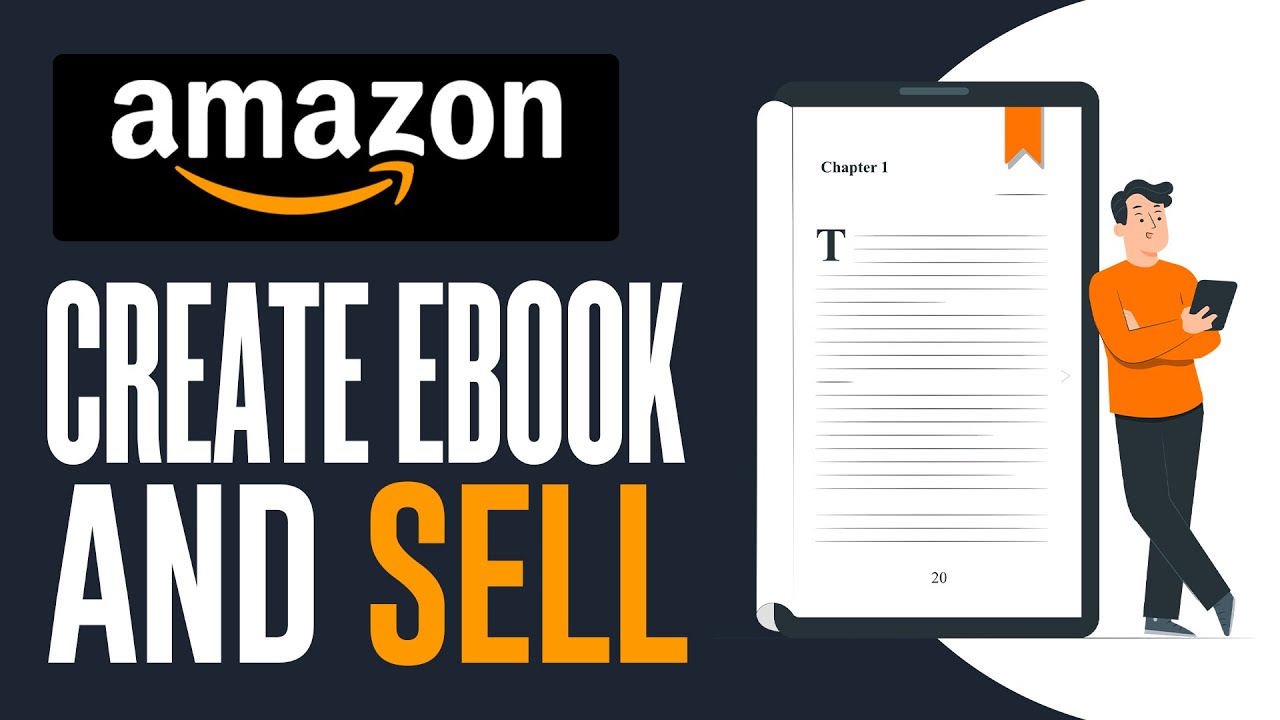Introduction
Welcome to the exciting world of selling your eBook on Amazon! With millions of users and a massive customer base, Amazon offers incredible potential for authors to reach a wide audience and generate significant sales. Whether you’re a seasoned writer or just starting your publishing journey, this guide will walk you through the essential steps to successfully sell your eBook on Amazon.
Selling your eBook on Amazon provides numerous advantages. Firstly, it allows you to tap into a vast customer base actively seeking books in various genres and categories. Secondly, Amazon’s advanced recommendation algorithms can help boost the visibility of your eBook and expose it to potential readers who may be interested in your niche or writing style.
Before you begin, it’s important to note that while Amazon can provide a powerful platform for selling your eBook, competition is fierce. The marketplace is saturated with eBooks, making it crucial to stand out from the crowd. But fret not, with the right strategies and a carefully planned approach, you can increase your chances of success.
In this guide, we’ll cover everything from setting up your Amazon account and formatting your eBook to effectively marketing and analyzing your sales. By the end, you’ll have a comprehensive understanding of how to navigate the world of eBook publishing on Amazon and maximize your potential for success.
Ready to take the plunge and bring your eBook to millions of readers worldwide? Let’s get started!
Setting Up Your Amazon Account
Before you can begin selling your eBook on Amazon, you’ll need to set up an account as a Kindle Direct Publishing (KDP) author. Here’s a step-by-step guide on how to get started:
- Create an Amazon Account: If you don’t already have an Amazon account, head to the Amazon homepage and click on the “Sign In” button at the top right corner. From there, select “Create your Amazon account” and follow the prompts to set up your account details.
- Sign Up for KDP: Once you have an Amazon account, go to the Kindle Direct Publishing website (kdp.amazon.com) and click on “Sign In.” Use your Amazon account credentials to sign in, or select “Sign up” if you’re a new user.
- Add Your Author Details: After signing in to your KDP account, click on “Your Account” in the top right corner, then select “Account Details.” Fill in your author information, including your name, pen name (if applicable), contact information, and payment details.
- Tax and Banking Information: Under the “Account Details” section, you’ll need to provide your tax and banking information for royalty payments. Follow the instructions to complete this step accurately.
- Set Up Your eBook Royalty Options: KDP offers two royalty options: 35% and 70%. The 70% option is available for eBooks priced between $2.99 and $9.99 and meets certain criteria. Choose the option that best suits your eBook and pricing strategy.
- Verify Your Email Address: Amazon will send a verification email to the address associated with your account. Click on the verification link provided in the email to confirm your email address.
- Set Up Two-Factor Authentication: To enhance the security of your KDP account, it’s recommended to enable two-factor authentication. This adds an extra layer of protection to prevent unauthorized access.
Once you’ve completed these steps, congratulations! You’re now ready to start publishing your eBook on Amazon. In the next sections, we’ll dive into the necessary formatting, cover design, and book description techniques to make your eBook shine.
Formatting Your eBook for Amazon
Proper formatting is crucial to ensure that your eBook looks professional and is easy to read on various Kindle devices. Here are some essential tips to follow when formatting your eBook for Amazon:
- File Format: Amazon accepts eBooks in various formats, but the most recommended is the MOBI format. You can use online converters or eBook formatting tools like Calibre to convert your manuscript into the MOBI format.
- Table of Contents: Include a well-formatted table of contents that allows readers to navigate through your eBook easily. Ensure that each chapter or section is properly labeled and hyperlinked to the corresponding page.
- Font and Typography: Select a clean and legible font for your eBook’s body text, such as Arial or Times New Roman. Stick to a reasonable font size (e.g., 11 or 12 points) to ensure readability. Avoid using fancy or decorative fonts that may be difficult to read on Kindle devices.
- Paragraph Formatting: Use proper indentation for paragraphs and separate them with an empty line. This makes your eBook visually appealing and easier to read on different devices.
- Images and Graphics: If your eBook contains images or graphics, optimize them for Kindle devices. Ensure they are of high quality and don’t significantly slow down the load time of your eBook.
- Hyperlinks and Footnotes: If you have external links or footnotes within your eBook, make sure they are properly hyperlinked and functional. Readers should be able to click on them to navigate to the referenced content or footnote section.
- Proofreading and Editing: Before publishing, thoroughly proofread and edit your eBook to eliminate any typos, grammatical errors, or formatting issues. It’s a good idea to have someone else review your eBook as well to catch any mistakes you may have missed.
Keep in mind that Amazon has specific guidelines and recommendations for eBook formatting, so it’s essential to review their guidelines and ensure your eBook meets their requirements. Taking the time to properly format your eBook will enhance its overall presentation and make it more appealing to readers.
In the next section, we’ll explore how to create an eye-catching eBook cover that grabs attention and effectively represents your content.
Creating an Eye-Catching eBook Cover
An eye-catching eBook cover is essential for attracting potential readers and making your book stand out among the competition on Amazon. Here are some tips to help you create a compelling eBook cover:
- Research Cover Designs: Take some time to research popular and successful eBook covers in your genre. Look for common design elements and color schemes that resonate with your target audience. This will give you an idea of what works well and help you brainstorm ideas for your own cover.
- Focus on Visual Appeal: Your eBook cover should be visually appealing and grab the attention of potential readers. Use high-resolution images or illustrations that relate to the content of your book and evoke interest or emotions.
- Clear Title and Author Name: Ensure that the title of your book is clear, bold, and easy to read even in thumbnail size. Choose a font that matches the genre and theme of your eBook. Similarly, prominently display your author name to build brand recognition.
- Use Contrasting Colors: Choose colors that create contrast and make the text and images on your cover stand out. Contrast helps make your cover visually striking and easy to recognize when displayed alongside other eBooks on Amazon.
- Keep it Simple: Avoid cluttering your cover with too many graphics or text. A clean and uncluttered design tends to be more visually appealing and helps convey the main message of your eBook more effectively. Remember, simplicity is key.
- Create a Consistent Brand: If you have a logo or a specific branding style, consider incorporating it into your eBook cover. This helps establish a consistent brand identity and makes it easier for readers to recognize your work in the future.
- Test and Get Feedback: Once you have a design in mind, test it out by getting feedback from friends, fellow authors, or potential readers. Their input can provide valuable insights and help you make any necessary adjustments before finalizing your eBook cover.
If you’re not confident in your design skills, consider hiring a professional graphic designer who specializes in book cover design. Investing in a high-quality cover can significantly impact the success of your eBook on Amazon.
Now that you know how to create an eye-catching eBook cover, let’s move on to crafting an engaging book description that entices readers to click on your eBook and make a purchase.
Writing an Engaging Book Description
An engaging book description is crucial for enticing potential readers to click on your eBook and learn more about what it has to offer. Here are some tips to help you write a captivating book description:
- Know Your Target Audience: Understand who your target audience is and what they are looking for in a book. Tailor your book description to appeal directly to their desires, interests, and needs.
- Start with a Hook: Begin your book description with a compelling hook that grabs the reader’s attention. This could be a thought-provoking question, a captivating statement, or an intriguing fact that piques their curiosity.
- Highlight the Main Characters or Themes: Give readers a glimpse into the main characters or themes of your eBook. Show them why they should care about your story and what unique elements it brings to the table.
- Use Vivid Language: Make your book description come alive by using vivid and descriptive language. Paint a picture in the reader’s mind and evoke emotions that connect them to the story or topic of your eBook.
- Create Suspense: Tease readers by dropping hints or creating suspense about the twists, turns, or mysteries they can expect to find in your eBook. Leave them wanting more, eager to uncover what lies within the pages.
- Show Benefits and Unique Selling Points: Highlight the benefits that readers will gain by reading your eBook. Whether it’s learning something new, being entertained, or experiencing a transformative journey, clearly articulate the unique selling points of your book.
- Include Testimonials or Reviews: If you have received positive reviews or testimonials for your book, consider including them in the book description. This adds credibility and social proof, boosting the reader’s confidence in your work.
- End with a Call-to-Action: Conclude your book description with a strong call-to-action that prompts readers to take the next step, such as “click the buy now button” or “grab your copy today.” Encourage them to act now rather than later.
Remember to keep your book description concise, engaging, and to the point. Be mindful of using keywords relevant to your eBook’s genre and target audience to optimize it for searchability on Amazon.
In the next section, we’ll explore choosing the right keywords and categories to help your eBook get discovered by potential readers on Amazon.
Choosing the Right Keywords and Categories
Choosing the right keywords and categories for your eBook is essential for increasing its visibility and ensuring that it reaches the right readers on Amazon. Here are some tips to help you select the optimal keywords and categories:
- Research Relevant Keywords: Conduct thorough keyword research to identify words and phrases that are commonly searched for in relation to your eBook’s genre or topic. Tools like Google Keyword Planner or Amazon’s own keyword research tool can assist you in finding highly relevant keywords.
- Focus on Specificity: Choose keywords that are specific and reflect the unique aspects of your eBook. Generic keywords may have a higher search volume, but they also have higher competition. Targeting more specific keywords will help you attract a more targeted and engaged audience.
- Include Long-Tail Keywords: Long-tail keywords are longer phrases that are more specific to your eBook. They often have less competition and can help you reach readers who are specifically looking for the type of content you offer. Incorporate these long-tail keywords into your book title, subtitle, and book description.
- Utilize Backend Keywords: Amazon provides you with backend keyword fields where you can input additional keywords that are not visible to readers but help improve your eBook’s discoverability. Use this space wisely by including relevant keywords that didn’t fit into your visible book metadata.
- Research Categories: Browse through Amazon’s category list and identify the most suitable category for your eBook. Choose a category that accurately represents the main genre or topic of your book. Additionally, consider choosing a subcategory that has less competition but is still relevant to your eBook.
- Consider Using Keywords in Metadata: Place important keywords in strategic places such as the book title, subtitle, and author name. This can help improve your eBook’s ranking in Amazon’s search results and attract the attention of potential readers.
- Monitor and Refine: Periodically review the performance of your chosen keywords and categories. If you notice a decline in visibility or sales, consider experimenting with different keywords or categories to optimize your eBook’s discoverability.
Remember that the goal is to strike a balance between choosing keywords and categories that have a good search volume but aren’t overly competitive. By selecting the right keywords and categories, you can increase your eBook’s chances of appearing in relevant search results and reaching your target audience.
Now that you have an understanding of keywords and categories, let’s explore how to price your eBook effectively in the next section.
Pricing Your eBook
Setting the right price for your eBook is crucial for both attracting readers and maximizing your revenue on Amazon. Here are some key factors to consider when pricing your eBook:
- Research Competitor Pricing: Take a look at similar eBooks in your genre and analyze their pricing strategies. This will give you a benchmark for pricing your own eBook and help you stay competitive.
- Consider eBook Length and Content: Evaluate the length, quality, and uniqueness of your eBook’s content. If your book offers valuable and extensive information, you may be able to justify a higher price. Conversely, shorter or introductory eBooks may be priced lower.
- Know Your Target Audience: Understand the purchasing behavior and budget of your target audience. If your eBook caters to a niche market or offers specialized knowledge, you may be able to command a higher price. However, pricing too high may deter potential readers, so strike a balance.
- Use Price Tiering: Amazon allows you to set your eBook price within specific price tiers. Experiment with different pricing levels, such as $0.99, $2.99, $4.99, etc., to find the sweet spot that maximizes sales while providing good value for your readers.
- Consider Promotional Pricing: Temporarily discounting your eBook or running promotional campaigns can help attract new readers and increase your sales. Promotions can include limited-time discounts, free giveaways, or bundling your eBook with other related products.
- Monitor Sales and Adjust Pricing: Keep a close eye on your eBook’s sales performance and customer feedback. If you notice a decline in sales or negative reviews related to pricing, it may be a signal to reassess and adjust your eBook’s price accordingly.
- Utilize Amazon’s KDP Select Program: Consider enrolling your eBook in Amazon’s KDP Select program. This program allows you to offer your eBook for free to Kindle Unlimited subscribers, offering them unlimited access to your eBook for a fixed monthly fee, potentially reaching a larger audience.
Remember that pricing is not a one-time decision. It’s important to periodically review and adjust your eBook’s price to stay competitive and optimize your revenue without undervaluing your work.
In the next section, we’ll dive into the process of publishing your eBook on Amazon, turning your work into a digital reality for readers around the world.
Publishing Your eBook on Amazon
Publishing your eBook on Amazon is both exciting and straightforward. Here’s a step-by-step guide to help you navigate the process:
- Format Your eBook: Make sure your eBook is properly formatted according to Amazon’s guidelines. Ensure that it is in a compatible file format, such as MOBI, and that the content is error-free and easily readable on Kindle devices.
- Create a Compelling Book Title and Subtitle: Craft a captivating book title that grabs readers’ attention and accurately represents your eBook’s content. Additionally, include a subtitle that provides further clarity or intrigue about the book.
- Write an Engaging Book Description: Create a brief yet enticing book description that effectively summarizes your eBook’s main themes, hooks readers, and entices them to click the “Buy” button. Highlight the unique selling points and benefits of your book.
- Design a Captivating eBook Cover: Create an eye-catching and professional eBook cover that visually represents your book’s genre and grabs readers’ attention. Ensure that the title and author name are clear, legible, and prominent.
- Choose Relevant Categories: Select the most appropriate categories and subcategories for your eBook on Amazon. Choose categories that accurately reflect the genre and content of your book to maximize its visibility and target the right audience.
- Select Appropriate Keywords: Incorporate relevant and targeted keywords into your eBook’s metadata, including the title, subtitle, book description, and backend keyword fields. These keywords help improve your eBook’s discoverability in Amazon’s search results.
- Set the Right Price: Consider factors such as eBook length, market competition, and your target audience’s purchasing power when setting the price. Experiment with different price points and promotions to find the optimal balance between attracting readers and maximizing revenue.
- Upload Your eBook and Cover: Sign in to your Kindle Direct Publishing (KDP) account and upload your eBook file and cover image. Follow the on-screen instructions to complete the uploading process, ensuring that your files meet Amazon’s file size and format requirements.
- Review and Publish: Once your eBook and cover are successfully uploaded, review and preview your book using Amazon’s built-in previewer. Check for any formatting or display issues and make necessary adjustments. Once satisfied, click “Publish” to release your eBook on Amazon.
- Set Up Amazon Author Central: Create an Amazon Author Central account to establish your author presence and access additional promotional tools. This allows you to create your author profile, add a bio, and track your sales and reviews.
After publishing your eBook, it may take a few hours or up to 72 hours for your book to become available for purchase on Amazon. Be patient and take this time to plan your marketing and promotion strategies to help your eBook gain visibility and attract readers.
Congratulations! You have successfully published your eBook on Amazon. In the next section, we’ll explore effective marketing techniques to help you promote and get your eBook in front of your target audience.
Marketing and Promoting Your eBook
Marketing and promoting your eBook are crucial steps to help it gain visibility, attract readers, and ultimately increase sales on Amazon. Here are some effective strategies to market and promote your eBook:
- Utilize Social Media: Leverage the power of social media platforms like Facebook, Twitter, Instagram, and LinkedIn to build an online presence and promote your eBook. Share engaging content, create visually appealing graphics, and interact with your target audience.
- Build an Author Website or Blog: Create a website or blog dedicated to your eBook and author brand. Include relevant information about your eBook, author bio, sample chapters, and links to purchase. Regularly update your website with fresh content and engage with your readers through comments and newsletters.
- Reach Out to Book Reviewers and Bloggers: Identify book reviewers and bloggers in your genre and reach out to them to request reviews or interviews. Positive reviews and exposure from reputable sources can boost your eBook’s credibility and attract more readers.
- Run Limited-Time Promotions: Create a sense of urgency by offering limited-time promotions or discounts for your eBook. Amazon’s KDP platform allows you to run promotional deals, such as offering your eBook for free or at a discounted price, to attract readers and generate buzz.
- Engage in Guest Blogging: Seek opportunities to write guest blog posts for popular websites or blogs in your niche. Include a link to your eBook in your author bio or within the content to redirect interested readers to your Amazon product page.
- Consider eBook Advertising: Explore paid advertising options specific to eBooks, such as Amazon Advertising or book promotion websites. These platforms can help you reach a wider audience and increase the visibility of your eBook.
- Offer a Sample or Preview: Provide a free sample or preview of your eBook to potential readers. This allows them to get a taste of your writing style and story, enticing them to purchase the full eBook.
- Create Engaging Book Trailers or Videos: If you have the resources, consider creating a book trailer or video to promote your eBook. Videos can be eye-catching and engaging, providing a dynamic way to showcase the key elements of your eBook and generate interest.
- Engage with Your Readers: Interact with your readers and respond to their comments, reviews, and questions. Engaging with your audience builds trust, loyalty, and a sense of community around your eBook.
- Participate in Virtual Events and Online Communities: Look for virtual events, webinars, or online communities related to your eBook’s genre or topic. Participate in discussions, share insights, and mention your eBook when appropriate. This can help you connect with potential readers and generate interest.
Remember, marketing and promotion require consistent effort and a proactive approach. Experiment with different strategies, track your results, and adapt your approach based on what works best for your eBook and target audience.
In the next section, we’ll discuss the importance of tracking and analyzing your eBook sales to gain insights and make informed decisions for future marketing efforts.
Tracking and Analyzing Your eBook Sales
Tracking and analyzing your eBook sales is crucial for gaining insights into your book’s performance, understanding reader behavior, and making informed decisions for future marketing efforts. Here are some key steps to effectively track and analyze your eBook sales:
- Use Amazon KDP Sales Dashboard: Amazon’s Kindle Direct Publishing (KDP) provides a sales dashboard that displays vital sales data, including the number of units sold, royalties earned, and sales by marketplace. Regularly monitor these metrics to understand your eBook’s performance.
- Track Sales by Time Period: Analyze your eBook sales on a daily, weekly, monthly, or quarterly basis to identify trends and patterns. Look for any spikes or dips in sales and try to understand the factors influencing those fluctuations.
- Analyze Demographic Data: Utilize the demographic data available in your sales dashboard to gain insights into your readers’ location and purchasing behavior. This information can help you tailor your marketing efforts and target specific demographics more effectively.
- Monitor Customer Reviews: Pay close attention to customer reviews and ratings. Positive reviews can validate your eBook’s quality and attract more readers, while negative reviews can provide valuable feedback for improvement. Respond thoughtfully to reviews and engage with your readers.
- Experiment with Promotions: Keep track of the impact of your promotional campaigns on your eBook’s sales. Note any surges in sales during promotional periods and evaluate the effectiveness of different marketing strategies. This data will guide you in making informed decisions about future promotions.
- Monitor Rankings and Bestseller Lists: Observe your eBook’s rankings in relevant categories and bestseller lists on Amazon. Changes in rankings can provide insights into the effectiveness of your marketing efforts and help identify areas for improvement.
- Collect Feedback and Surveys: Engage with your readers and ask for their feedback through surveys or direct communication. Gain insights into their preferences, expectations, and suggestions for improvement. This feedback can guide you in refining your eBook and future marketing strategies.
- Track External Marketing Efforts: If you engage in external marketing efforts, such as advertising campaigns on other platforms, use unique tracking links to monitor their impact on sales. This will help you assess the effectiveness of different marketing channels.
- Continuously Adapt and Improve: Use the data and insights gathered from tracking and analysis to refine your marketing approach. Adjust your strategies, pricing, book description, or target audience as necessary to optimize your eBook’s performance and increase sales.
Regularly tracking and analyzing your eBook sales is an ongoing process. It allows you to make data-driven decisions to improve your marketing efforts, enhance the reader experience, and ultimately increase your eBook’s success on Amazon.
With the knowledge gained from tracking and analyzing your eBook sales, you’ll be better equipped to make informed decisions for future iterations of your eBook or for future publications.
Conclusion
Congratulations on reaching the end of this guide on selling your eBook on Amazon! We’ve covered the essential steps to help you successfully navigate the process, from setting up your Amazon account to tracking and analyzing your eBook sales. By following these steps, you can increase your chances of reaching a wider audience, generating sales, and achieving your eBook publishing goals.
Remember, selling your eBook on Amazon requires a comprehensive approach that encompasses various aspects—such as formatting, cover design, book description, keywords, pricing, and marketing. Each element plays a crucial role in attracting readers and making your eBook stand out in a crowded marketplace.
As you embark on your eBook publishing journey, keep in mind that success may not happen overnight. It takes time, effort, and a willingness to adapt and improve. Pay attention to reader feedback, stay informed about industry trends, and continuously fine-tune your strategies to optimize your eBook’s performance.
Finally, embrace the opportunity to connect with readers and fellow authors. Engage in online communities, collaborate with others, and build a network of support and inspiration. Remember that writing and publishing are not solitary endeavors; they are opportunities to share your creativity and knowledge with the world.
Now it’s time to implement what you’ve learned and take action. Set up your Amazon account, format your eBook, create an eye-catching cover, and promote your eBook to reach your target audience. The world of eBook publishing on Amazon is waiting for you, so dive in and share your story with readers around the globe.
Happy publishing!

























